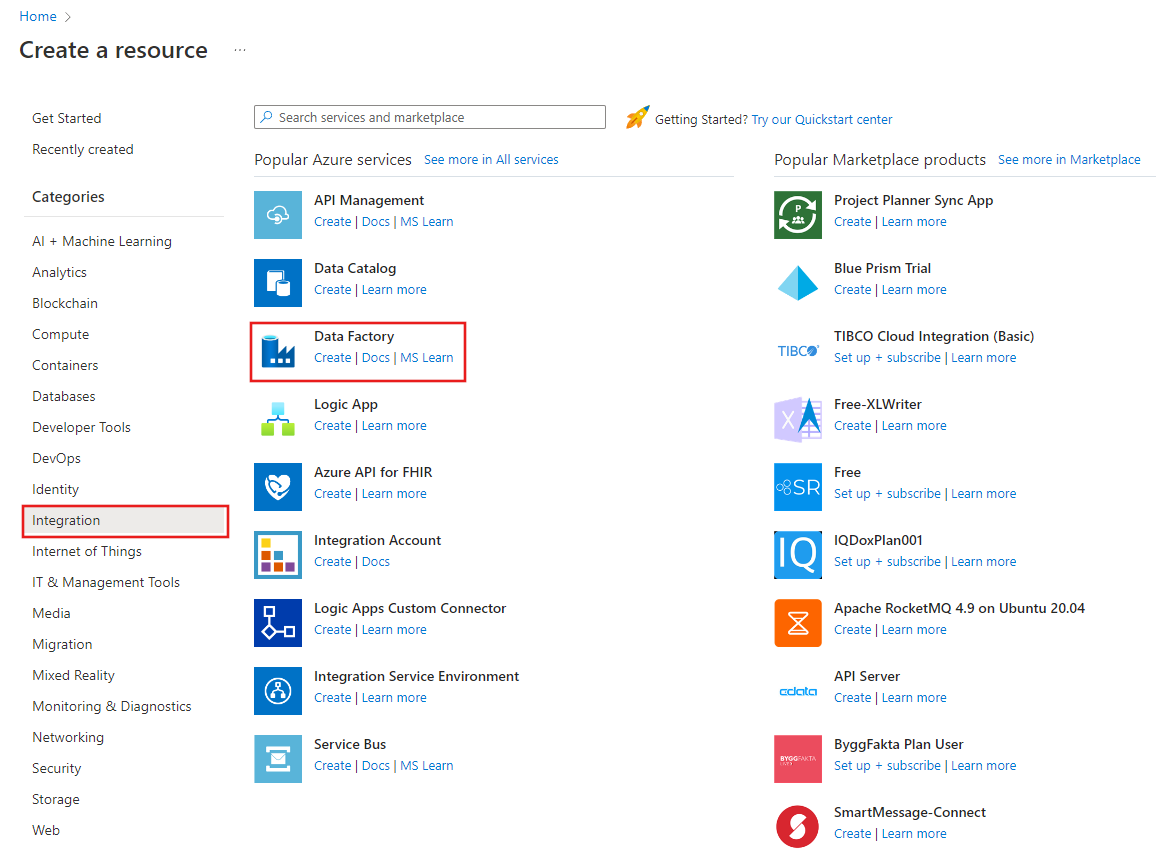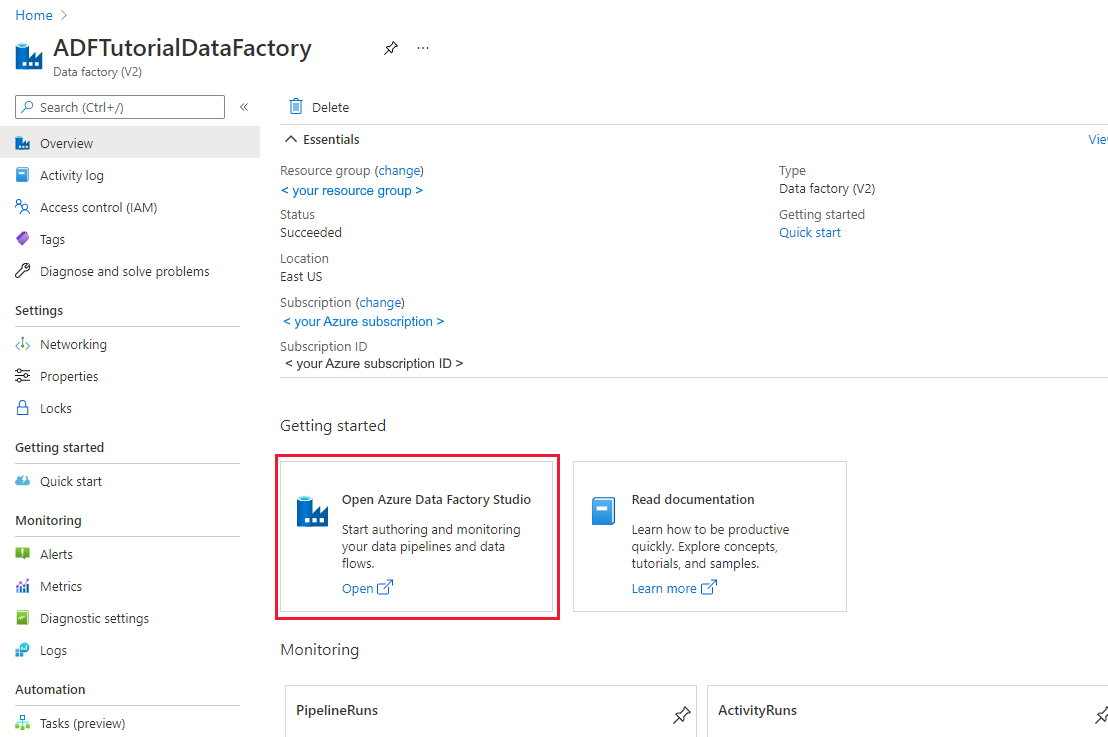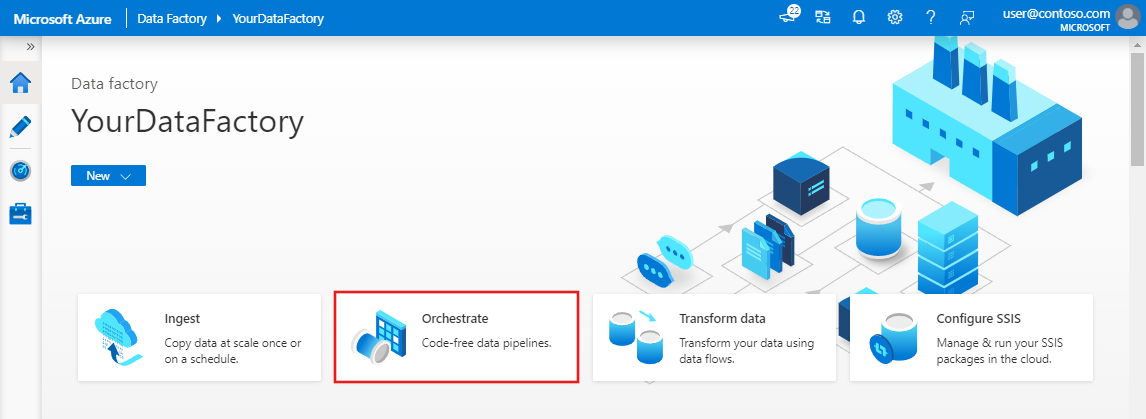Incrementally load data from Azure SQL Database to Azure Blob storage using the Azure portal
APPLIES TO:  Azure Data Factory
Azure Data Factory  Azure Synapse Analytics
Azure Synapse Analytics
Tip
Try out Data Factory in Microsoft Fabric, an all-in-one analytics solution for enterprises. Microsoft Fabric covers everything from data movement to data science, real-time analytics, business intelligence, and reporting. Learn how to start a new trial for free!
In this tutorial, you create an Azure Data Factory with a pipeline that loads delta data from a table in Azure SQL Database to Azure Blob storage.
You perform the following steps in this tutorial:
- Prepare the data store to store the watermark value.
- Create a data factory.
- Create linked services.
- Create source, sink, and watermark datasets.
- Create a pipeline.
- Run the pipeline.
- Monitor the pipeline run.
- Review results
- Add more data to the source.
- Run the pipeline again.
- Monitor the second pipeline run
- Review results from the second run
Overview
Here is the high-level solution diagram:

Here are the important steps to create this solution:
Select the watermark column. Select one column in the source data store, which can be used to slice the new or updated records for every run. Normally, the data in this selected column (for example, last_modify_time or ID) keeps increasing when rows are created or updated. The maximum value in this column is used as a watermark.
Prepare a data store to store the watermark value. In this tutorial, you store the watermark value in a SQL database.
Create a pipeline with the following workflow:
The pipeline in this solution has the following activities:
- Create two Lookup activities. Use the first Lookup activity to retrieve the last watermark value. Use the second Lookup activity to retrieve the new watermark value. These watermark values are passed to the Copy activity.
- Create a Copy activity that copies rows from the source data store with the value of the watermark column greater than the old watermark value and less than the new watermark value. Then, it copies the delta data from the source data store to Blob storage as a new file.
- Create a StoredProcedure activity that updates the watermark value for the pipeline that runs next time.
If you don't have an Azure subscription, create a free account before you begin.
Prerequisites
- Azure SQL Database. You use the database as the source data store. If you don't have a database in Azure SQL Database, see Create a database in Azure SQL Database for steps to create one.
- Azure Storage. You use the blob storage as the sink data store. If you don't have a storage account, see Create a storage account for steps to create one. Create a container named adftutorial.
Create a data source table in your SQL database
Open SQL Server Management Studio. In Server Explorer, right-click the database, and choose New Query.
Run the following SQL command against your SQL database to create a table named
data_source_tableas the data source store:create table data_source_table ( PersonID int, Name varchar(255), LastModifytime datetime ); INSERT INTO data_source_table (PersonID, Name, LastModifytime) VALUES (1, 'aaaa','9/1/2017 12:56:00 AM'), (2, 'bbbb','9/2/2017 5:23:00 AM'), (3, 'cccc','9/3/2017 2:36:00 AM'), (4, 'dddd','9/4/2017 3:21:00 AM'), (5, 'eeee','9/5/2017 8:06:00 AM');In this tutorial, you use LastModifytime as the watermark column. The data in the data source store is shown in the following table:
PersonID | Name | LastModifytime -------- | ---- | -------------- 1 | aaaa | 2017-09-01 00:56:00.000 2 | bbbb | 2017-09-02 05:23:00.000 3 | cccc | 2017-09-03 02:36:00.000 4 | dddd | 2017-09-04 03:21:00.000 5 | eeee | 2017-09-05 08:06:00.000
Create another table in your SQL database to store the high watermark value
Run the following SQL command against your SQL database to create a table named
watermarktableto store the watermark value:create table watermarktable ( TableName varchar(255), WatermarkValue datetime, );Set the default value of the high watermark with the table name of source data store. In this tutorial, the table name is data_source_table.
INSERT INTO watermarktable VALUES ('data_source_table','1/1/2010 12:00:00 AM')Review the data in the table
watermarktable.Select * from watermarktableOutput:
TableName | WatermarkValue ---------- | -------------- data_source_table | 2010-01-01 00:00:00.000
Create a stored procedure in your SQL database
Run the following command to create a stored procedure in your SQL database:
CREATE PROCEDURE usp_write_watermark @LastModifiedtime datetime, @TableName varchar(50)
AS
BEGIN
UPDATE watermarktable
SET [WatermarkValue] = @LastModifiedtime
WHERE [TableName] = @TableName
END
Create a data factory
Launch Microsoft Edge or Google Chrome web browser. Currently, Data Factory UI is supported only in Microsoft Edge and Google Chrome web browsers.
On the left menu, select Create a resource > Integration > Data Factory:

In the New data factory page, enter ADFIncCopyTutorialDF for the name.
The name of the Azure Data Factory must be globally unique. If you see a red exclamation mark with the following error, change the name of the data factory (for example, yournameADFIncCopyTutorialDF) and try creating again. See Data Factory - Naming Rules article for naming rules for Data Factory artifacts.
Data factory name "ADFIncCopyTutorialDF" is not available
Select your Azure subscription in which you want to create the data factory.
For the Resource Group, do one of the following steps:
Select Use existing, and select an existing resource group from the drop-down list.
Select Create new, and enter the name of a resource group.
To learn about resource groups, see Using resource groups to manage your Azure resources.
Select V2 for the version.
Select the location for the data factory. Only locations that are supported are displayed in the drop-down list. The data stores (Azure Storage, Azure SQL Database, Azure SQL Managed Instance, and so on) and computes (HDInsight, etc.) used by data factory can be in other regions.
Click Create.
After the creation is complete, you see the Data Factory page as shown in the image.

Select Open on the Open Azure Data Factory Studio tile to launch the Azure Data Factory user interface (UI) in a separate tab.
Create a pipeline
In this tutorial, you create a pipeline with two Lookup activities, one Copy activity, and one StoredProcedure activity chained in one pipeline.
On the home page of Data Factory UI, click the Orchestrate tile.

In the General panel under Properties, specify IncrementalCopyPipeline for Name. Then collapse the panel by clicking the Properties icon in the top-right corner.
Let's add the first lookup activity to get the old watermark value. In the Activities toolbox, expand General, and drag-drop the Lookup activity to the pipeline designer surface. Change the name of the activity to LookupOldWaterMarkActivity.

Switch to the Settings tab, and click + New for Source Dataset. In this step, you create a dataset to represent data in the watermarktable. This table contains the old watermark that was used in the previous copy operation.
In the New Dataset window, select Azure SQL Database, and click Continue. You see a new window opened for the dataset.
In the Set properties window for the dataset, enter WatermarkDataset for Name.
For Linked Service, select New, and then do the following steps:
Enter AzureSqlDatabaseLinkedService for Name.
Select your server for Server name.
Select your Database name from the dropdown list.
Enter your User name & Password.
To test connection to the your SQL database, click Test connection.
Click Finish.
Confirm that AzureSqlDatabaseLinkedService is selected for Linked service.

Select Finish.
In the Connection tab, select [dbo].[watermarktable] for Table. If you want to preview data in the table, click Preview data.

Switch to the pipeline editor by clicking the pipeline tab at the top or by clicking the name of the pipeline in the tree view on the left. In the properties window for the Lookup activity, confirm that WatermarkDataset is selected for the Source Dataset field.
In the Activities toolbox, expand General, and drag-drop another Lookup activity to the pipeline designer surface, and set the name to LookupNewWaterMarkActivity in the General tab of the properties window. This Lookup activity gets the new watermark value from the table with the source data to be copied to the destination.
In the properties window for the second Lookup activity, switch to the Settings tab, and click New. You create a dataset to point to the source table that contains the new watermark value (maximum value of LastModifyTime).
In the New Dataset window, select Azure SQL Database, and click Continue.
In the Set properties window, enter SourceDataset for Name. Select AzureSqlDatabaseLinkedService for Linked service.
Select [dbo].[data_source_table] for Table. You specify a query on this dataset later in the tutorial. The query takes the precedence over the table you specify in this step.
Select Finish.
Switch to the pipeline editor by clicking the pipeline tab at the top or by clicking the name of the pipeline in the tree view on the left. In the properties window for the Lookup activity, confirm that SourceDataset is selected for the Source Dataset field.
Select Query for the Use Query field, and enter the following query: you are only selecting the maximum value of LastModifytime from the data_source_table. Please make sure you have also checked First row only.
select MAX(LastModifytime) as NewWatermarkvalue from data_source_table
In the Activities toolbox, expand Move & Transform, and drag-drop the Copy activity from the Activities toolbox, and set the name to IncrementalCopyActivity.
Connect both Lookup activities to the Copy activity by dragging the green button attached to the Lookup activities to the Copy activity. Release the mouse button when you see the border color of the Copy activity changes to blue.

Select the Copy activity and confirm that you see the properties for the activity in the Properties window.
Switch to the Source tab in the Properties window, and do the following steps:
Select SourceDataset for the Source Dataset field.
Select Query for the Use Query field.
Enter the following SQL query for the Query field.
select * from data_source_table where LastModifytime > '@{activity('LookupOldWaterMarkActivity').output.firstRow.WatermarkValue}' and LastModifytime <= '@{activity('LookupNewWaterMarkActivity').output.firstRow.NewWatermarkvalue}'
Switch to the Sink tab, and click + New for the Sink Dataset field.
In this tutorial sink data store is of type Azure Blob Storage. Therefore, select Azure Blob Storage, and click Continue in the New Dataset window.
In the Select Format window, select the format type of your data, and click Continue.
In the Set Properties window, enter SinkDataset for Name. For Linked Service, select + New. In this step, you create a connection (linked service) to your Azure Blob storage.
In the New Linked Service (Azure Blob Storage) window, do the following steps:
- Enter AzureStorageLinkedService for Name.
- Select your Azure Storage account for Storage account name.
- Test Connection and then click Finish.
In the Set Properties window, confirm that AzureStorageLinkedService is selected for Linked service. Then select Finish.
Go to the Connection tab of SinkDataset and do the following steps:
- For the File path field, enter adftutorial/incrementalcopy. adftutorial is the blob container name and incrementalcopy is the folder name. This snippet assumes that you have a blob container named adftutorial in your blob storage. Create the container if it doesn't exist, or set it to the name of an existing one. Azure Data Factory automatically creates the output folder incrementalcopy if it does not exist. You can also use the Browse button for the File path to navigate to a folder in a blob container.
- For the File part of the File path field, select Add dynamic content [Alt+P], and then enter
@CONCAT('Incremental-', pipeline().RunId, '.txt')in the opened window. Then select Finish. The file name is dynamically generated by using the expression. Each pipeline run has a unique ID. The Copy activity uses the run ID to generate the file name.
Switch to the pipeline editor by clicking the pipeline tab at the top or by clicking the name of the pipeline in the tree view on the left.
In the Activities toolbox, expand General, and drag-drop the Stored Procedure activity from the Activities toolbox to the pipeline designer surface. Connect the green (Success) output of the Copy activity to the Stored Procedure activity.
Select Stored Procedure Activity in the pipeline designer, change its name to StoredProceduretoWriteWatermarkActivity.
Switch to the SQL Account tab, and select AzureSqlDatabaseLinkedService for Linked service.
Switch to the Stored Procedure tab, and do the following steps:
For Stored procedure name, select usp_write_watermark.
To specify values for the stored procedure parameters, click Import parameter, and enter following values for the parameters:
Name Type Value LastModifiedtime DateTime @{activity('LookupNewWaterMarkActivity').output.firstRow.NewWatermarkvalue} TableName String @{activity('LookupOldWaterMarkActivity').output.firstRow.TableName} 
To validate the pipeline settings, click Validate on the toolbar. Confirm that there are no validation errors. To close the Pipeline Validation Report window, click >>.
Publish entities (linked services, datasets, and pipelines) to the Azure Data Factory service by selecting the Publish All button. Wait until you see a message that the publishing succeeded.
Trigger a pipeline run
Click Add Trigger on the toolbar, and click Trigger Now.
In the Pipeline Run window, select Finish.
Monitor the pipeline run
Switch to the Monitor tab on the left. You see the status of the pipeline run triggered by a manual trigger. You can use links under the PIPELINE NAME column to view run details and to rerun the pipeline.
To see activity runs associated with the pipeline run, select the link under the PIPELINE NAME column. For details about the activity runs, select the Details link (eyeglasses icon) under the ACTIVITY NAME column. Select All pipeline runs at the top to go back to the Pipeline Runs view. To refresh the view, select Refresh.
Review the results
Connect to your Azure Storage Account by using tools such as Azure Storage Explorer. Verify that an output file is created in the incrementalcopy folder of the adftutorial container.

Open the output file and notice that all the data is copied from the data_source_table to the blob file.
1,aaaa,2017-09-01 00:56:00.0000000 2,bbbb,2017-09-02 05:23:00.0000000 3,cccc,2017-09-03 02:36:00.0000000 4,dddd,2017-09-04 03:21:00.0000000 5,eeee,2017-09-05 08:06:00.0000000Check the latest value from
watermarktable. You see that the watermark value was updated.Select * from watermarktableHere is the output:
| TableName | WatermarkValue | | --------- | -------------- | | data_source_table | 2017-09-05 8:06:00.000 |
Add more data to source
Insert new data into your database (data source store).
INSERT INTO data_source_table
VALUES (6, 'newdata','9/6/2017 2:23:00 AM')
INSERT INTO data_source_table
VALUES (7, 'newdata','9/7/2017 9:01:00 AM')
The updated data in the your database is:
PersonID | Name | LastModifytime
-------- | ---- | --------------
1 | aaaa | 2017-09-01 00:56:00.000
2 | bbbb | 2017-09-02 05:23:00.000
3 | cccc | 2017-09-03 02:36:00.000
4 | dddd | 2017-09-04 03:21:00.000
5 | eeee | 2017-09-05 08:06:00.000
6 | newdata | 2017-09-06 02:23:00.000
7 | newdata | 2017-09-07 09:01:00.000
Trigger another pipeline run
Switch to the Edit tab. Click the pipeline in the tree view if it's not opened in the designer.
Click Add Trigger on the toolbar, and click Trigger Now.
Monitor the second pipeline run
Switch to the Monitor tab on the left. You see the status of the pipeline run triggered by a manual trigger. You can use links under the PIPELINE NAME column to view activity details and to rerun the pipeline.
To see activity runs associated with the pipeline run, select the link under the PIPELINE NAME column. For details about the activity runs, select the Details link (eyeglasses icon) under the ACTIVITY NAME column. Select All pipeline runs at the top to go back to the Pipeline Runs view. To refresh the view, select Refresh.
Verify the second output
In the blob storage, you see that another file was created. In this tutorial, the new file name is
Incremental-<GUID>.txt. Open that file, and you see two rows of records in it.6,newdata,2017-09-06 02:23:00.0000000 7,newdata,2017-09-07 09:01:00.0000000Check the latest value from
watermarktable. You see that the watermark value was updated again.Select * from watermarktableSample output:
| TableName | WatermarkValue | | --------- | -------------- | | data_source_table | 2017-09-07 09:01:00.000 |
Related content
You performed the following steps in this tutorial:
- Prepare the data store to store the watermark value.
- Create a data factory.
- Create linked services.
- Create source, sink, and watermark datasets.
- Create a pipeline.
- Run the pipeline.
- Monitor the pipeline run.
- Review results
- Add more data to the source.
- Run the pipeline again.
- Monitor the second pipeline run
- Review results from the second run
In this tutorial, the pipeline copied data from a single table in SQL Database to Blob storage. Advance to the following tutorial to learn how to copy data from multiple tables in a SQL Server database to SQL Database.